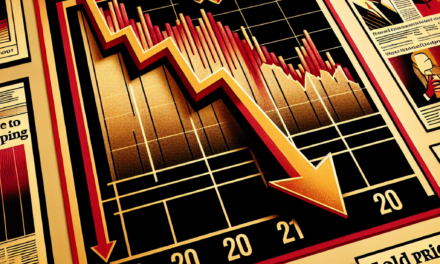“Navigating Uncertainty: S&P 500’s Struggle to Maintain Momentum Post-Election”
Introduction
The S&P 500, a key benchmark for U.S. equities, is encountering significant challenges in maintaining its upward momentum following recent post-election gains. As investors navigate a complex landscape marked by economic uncertainties, policy shifts, and global market dynamics, the index’s performance is under scrutiny. Factors such as inflationary pressures, interest rate adjustments by the Federal Reserve, and geopolitical tensions are contributing to market volatility. This market update delves into the current hurdles facing the S&P 500, analyzing the potential impact on investor sentiment and the broader economic outlook.
Impact Of Political Uncertainty On S&P 500 Performance
The S&P 500, a benchmark index representing the performance of 500 leading publicly traded companies in the United States, often serves as a barometer for the overall health of the U.S. economy. In the wake of recent elections, the index has experienced notable fluctuations, reflecting the market’s response to political developments. While post-election periods can sometimes bring a sense of stability and optimism, the current landscape is marked by a series of challenges that threaten to undermine these gains. Political uncertainty, in particular, plays a significant role in shaping investor sentiment and, consequently, the performance of the S&P 500.
To begin with, the outcome of elections can lead to shifts in policy direction, which in turn affect various sectors differently. For instance, changes in tax policy, regulatory frameworks, and government spending priorities can create winners and losers among industries. Investors, therefore, must navigate these potential changes, often leading to increased volatility in the market. This volatility is further exacerbated by the uncertainty surrounding the implementation and impact of new policies. As a result, the S&P 500 may experience short-term gains as investors react to anticipated policy shifts, but sustaining these gains requires clarity and confidence in the political landscape.
Moreover, the current political climate is characterized by heightened polarization, which can impede the legislative process and create gridlock. This gridlock can delay the passage of key economic policies, such as infrastructure spending or healthcare reform, which are crucial for driving growth. Consequently, the lack of progress on these fronts can dampen investor enthusiasm and weigh on the S&P 500’s performance. Additionally, political uncertainty can lead to fluctuations in consumer and business confidence, further impacting economic activity and corporate earnings. When confidence wanes, spending and investment tend to decrease, which can negatively affect the revenue and profitability of companies within the index.
Furthermore, geopolitical tensions and international relations add another layer of complexity to the political landscape. Trade policies, diplomatic relations, and global economic conditions all influence the S&P 500, as many of its constituent companies have significant international exposure. Uncertainty in these areas can lead to disruptions in supply chains, changes in trade agreements, and fluctuations in currency exchange rates, all of which can impact corporate performance. Investors must therefore consider not only domestic political developments but also the broader global context when assessing the S&P 500’s prospects.
In addition to these factors, the role of central banks and monetary policy cannot be overlooked. Political uncertainty can influence central bank decisions regarding interest rates and other monetary measures. For instance, if political developments are perceived as destabilizing, central banks may adopt a more accommodative stance to support economic growth. However, this can also lead to concerns about inflation and asset bubbles, which can create additional volatility in the market. The interplay between political uncertainty and monetary policy thus adds another dimension to the challenges faced by the S&P 500.
In conclusion, while the S&P 500 may experience post-election gains as investors react to anticipated policy changes, sustaining these gains is contingent upon a stable and predictable political environment. The current landscape, marked by political polarization, legislative gridlock, geopolitical tensions, and the influence of monetary policy, presents significant challenges. Investors must navigate these complexities, balancing optimism with caution, as they assess the potential impact on the S&P 500’s performance. As such, political uncertainty remains a critical factor influencing the index’s trajectory in the months ahead.
Analyzing Sectoral Shifts In The S&P 500 Post-Election
In the wake of the recent election, the S&P 500 has experienced a notable shift, reflecting the broader economic and political landscape. Investors are keenly observing these changes, as the index’s performance often serves as a barometer for the overall health of the U.S. economy. The post-election period has brought about a series of sectoral shifts within the S&P 500, driven by evolving investor sentiment and policy expectations. Understanding these shifts is crucial for stakeholders aiming to navigate the complexities of the current market environment.
To begin with, the technology sector, which has been a dominant force in the S&P 500 for several years, is facing new challenges. While tech companies have benefited from the accelerated digital transformation during the pandemic, the post-election climate has introduced uncertainties. Regulatory scrutiny and potential policy changes regarding data privacy and antitrust issues are causing investors to reassess their positions. Consequently, there has been a slight rotation away from tech stocks, as market participants seek to mitigate risks associated with increased government oversight.
In contrast, the energy sector is witnessing a resurgence, driven by expectations of favorable policy shifts. The election outcome has sparked optimism regarding infrastructure spending and clean energy initiatives, which could benefit traditional energy companies transitioning towards more sustainable practices. Additionally, the potential for increased government support for renewable energy projects has invigorated investor interest in this sector. As a result, energy stocks have gained traction, contributing to the sector’s improved performance within the S&P 500.
Moreover, the financial sector is experiencing a renewed sense of optimism. Anticipated regulatory changes and a potential rise in interest rates are factors that could enhance profitability for banks and financial institutions. The prospect of a more favorable economic environment, coupled with increased consumer spending, is likely to bolster the financial sector’s growth prospects. Consequently, investors are reallocating their portfolios to capitalize on these anticipated developments, leading to a positive impact on the sector’s representation in the S&P 500.
Meanwhile, the healthcare sector remains a focal point for investors, given its critical role in the ongoing public health landscape. The election has brought about discussions on healthcare reform and drug pricing policies, which could significantly impact the sector’s dynamics. While some investors remain cautious due to potential regulatory changes, others see opportunities in companies that are well-positioned to adapt to new policies. This dual sentiment is reflected in the sector’s mixed performance, as market participants weigh the risks and rewards associated with healthcare investments.
Furthermore, consumer discretionary stocks are experiencing a shift in investor sentiment. The post-election period has heightened expectations for economic recovery, which could boost consumer spending. However, inflationary pressures and supply chain disruptions pose challenges to this sector’s growth trajectory. Investors are closely monitoring these factors, as they could influence consumer behavior and, consequently, the performance of consumer discretionary stocks within the S&P 500.
In conclusion, the S&P 500 is navigating a complex landscape of sectoral shifts in the aftermath of the election. While some sectors are poised to benefit from anticipated policy changes and economic recovery, others face uncertainties that could impact their performance. Investors must remain vigilant and adaptable, as the interplay of political, economic, and regulatory factors continues to shape the market. By understanding these sectoral dynamics, stakeholders can make informed decisions to optimize their investment strategies in this evolving environment.
Historical Trends: S&P 500 Reactions To Election Outcomes
The S&P 500, a benchmark index representing the performance of 500 leading publicly traded companies in the United States, has historically exhibited varied reactions to presidential election outcomes. Understanding these historical trends provides valuable insights into the market’s behavior and its potential trajectory following elections. Over the years, the S&P 500’s response to election results has been influenced by a myriad of factors, including economic policies, investor sentiment, and geopolitical considerations.
Historically, the S&P 500 has shown a tendency to rally in the months following a presidential election, regardless of which party wins. This phenomenon can be attributed to the market’s preference for certainty and stability, as elections often resolve uncertainties surrounding future economic policies. For instance, after the 2016 election, the S&P 500 experienced a notable surge, driven by investor optimism about potential tax cuts and deregulation under the new administration. Similarly, the 2020 election saw the index climb as investors anticipated substantial fiscal stimulus and a robust economic recovery.
However, it is crucial to recognize that these post-election gains are not guaranteed and can be influenced by prevailing economic conditions and external factors. For example, the 2000 election, which resulted in a contested outcome and subsequent legal battles, led to heightened market volatility and a temporary decline in the S&P 500. This underscores the importance of political stability in fostering investor confidence and market growth.
Moreover, the S&P 500’s performance in the aftermath of an election is often shaped by the broader economic environment. In periods of economic expansion, the index tends to perform well as corporate earnings rise and consumer confidence strengthens. Conversely, during economic downturns, the market may struggle to sustain gains, as seen in the aftermath of the 2008 financial crisis. In such scenarios, the S&P 500’s trajectory is closely tied to the effectiveness of government policies in addressing economic challenges and restoring growth.
In addition to domestic factors, global events can also play a significant role in shaping the S&P 500’s post-election performance. Geopolitical tensions, trade disputes, and international economic developments can all impact investor sentiment and market dynamics. For instance, the ongoing trade tensions between the United States and China have periodically weighed on the S&P 500, highlighting the interconnectedness of global markets and the importance of international relations in influencing market outcomes.
As we consider the current landscape, the S&P 500 faces several challenges in sustaining post-election gains. The ongoing recovery from the COVID-19 pandemic, coupled with concerns about inflation and interest rate hikes, presents a complex backdrop for the market. Additionally, geopolitical uncertainties, such as tensions in Eastern Europe and the Middle East, add another layer of complexity to the market’s outlook.
In conclusion, while historical trends suggest that the S&P 500 often rallies following presidential elections, a multitude of factors can influence its performance. Political stability, economic conditions, and global events all play critical roles in determining the market’s trajectory. As investors navigate this intricate landscape, understanding these historical patterns and their underlying drivers can provide valuable guidance in anticipating the S&P 500’s future movements.
Investor Sentiment And Its Influence On S&P 500 Volatility

Investor sentiment plays a crucial role in shaping the volatility of the S&P 500, particularly in the aftermath of significant events such as elections. Following the recent election, the S&P 500 experienced notable gains, driven by optimism surrounding potential policy changes and economic recovery prospects. However, sustaining these gains presents a challenge, as investor sentiment can be highly volatile and influenced by a myriad of factors. Understanding the dynamics of investor sentiment and its impact on market volatility is essential for investors navigating the current landscape.
Initially, post-election optimism often leads to a surge in investor confidence, as market participants anticipate favorable policy shifts that could stimulate economic growth. This optimism can drive stock prices higher, contributing to the S&P 500’s upward trajectory. However, as the initial euphoria subsides, investors begin to scrutinize the feasibility and implementation of proposed policies. This shift in focus can lead to increased uncertainty, causing fluctuations in investor sentiment and, consequently, market volatility.
Moreover, external factors such as global economic conditions, geopolitical tensions, and unexpected events can further influence investor sentiment. For instance, concerns about inflation, interest rate hikes, or supply chain disruptions can dampen investor confidence, leading to increased market volatility. In such scenarios, the S&P 500 may experience sharp declines as investors reassess their risk tolerance and adjust their portfolios accordingly.
Additionally, the role of media and information dissemination cannot be overlooked in shaping investor sentiment. In today’s digital age, news travels rapidly, and market participants are constantly bombarded with information. Positive news can bolster investor confidence, while negative headlines can trigger panic selling. The speed at which information spreads can amplify market reactions, contributing to heightened volatility in the S&P 500.
Furthermore, the behavior of institutional investors and hedge funds can significantly impact market dynamics. These entities often employ sophisticated trading strategies that can exacerbate market movements. For example, algorithmic trading and high-frequency trading can lead to rapid buying or selling, intensifying market volatility. As institutional investors adjust their positions based on changing sentiment, their actions can have a cascading effect on the broader market.
In light of these factors, it is crucial for investors to adopt a disciplined approach to managing their portfolios. Diversification remains a key strategy to mitigate risk and reduce exposure to market volatility. By spreading investments across different asset classes and sectors, investors can cushion the impact of sudden market swings. Additionally, maintaining a long-term perspective can help investors navigate short-term volatility and focus on achieving their financial goals.
In conclusion, while the S&P 500 has experienced gains following the recent election, sustaining these gains amidst fluctuating investor sentiment presents a formidable challenge. The interplay of optimism, uncertainty, external factors, and institutional behavior contributes to market volatility. As investors navigate this complex landscape, understanding the influence of investor sentiment and employing prudent risk management strategies are essential for achieving long-term success. By staying informed and maintaining a disciplined approach, investors can better position themselves to weather the challenges and opportunities that lie ahead in the ever-evolving financial markets.
The Role Of Fiscal Policies In Shaping S&P 500 Trajectories
The S&P 500, a key barometer of the U.S. stock market’s health, has recently experienced fluctuations that have captured the attention of investors and analysts alike. In the wake of the latest election cycle, the index initially demonstrated a robust upward trajectory, buoyed by investor optimism and expectations of favorable economic policies. However, sustaining these post-election gains has proven challenging, as the market grapples with a complex interplay of fiscal policies and economic realities.
Fiscal policies, which encompass government spending and taxation decisions, play a pivotal role in shaping the trajectory of the S&P 500. These policies can either stimulate economic growth or impose constraints, depending on their design and implementation. In the current context, the market’s response to fiscal policies is particularly significant, as investors seek clarity on the government’s approach to addressing economic challenges such as inflation, unemployment, and public debt.
One of the primary concerns for investors is the potential impact of fiscal policies on inflation. In recent months, inflationary pressures have been mounting, driven by supply chain disruptions and increased consumer demand. The government’s fiscal response, including stimulus measures and infrastructure spending, has the potential to exacerbate these pressures if not carefully calibrated. Consequently, investors are closely monitoring policy announcements for indications of how inflation will be managed, as unchecked inflation could erode corporate profits and, by extension, the value of the S&P 500.
Moreover, taxation policies are another critical factor influencing the S&P 500’s performance. Proposals to increase corporate taxes have sparked debate among policymakers and market participants. While higher taxes could generate additional revenue for government programs, they may also reduce corporate earnings, thereby impacting stock valuations. Investors are particularly sensitive to changes in taxation policies, as these can directly affect the profitability of companies within the index. As such, any shifts in tax policy are likely to be met with heightened market volatility.
In addition to inflation and taxation, government spending priorities also play a crucial role in shaping market expectations. Infrastructure investments, for instance, have the potential to stimulate economic growth by creating jobs and enhancing productivity. However, the effectiveness of such spending depends on the timely and efficient execution of projects. Investors are keenly aware that delays or inefficiencies in government spending could dampen the anticipated economic benefits, thereby affecting the S&P 500’s outlook.
Furthermore, the broader economic environment, including global trade dynamics and geopolitical tensions, cannot be overlooked when considering the impact of fiscal policies on the S&P 500. Trade policies, in particular, have far-reaching implications for multinational corporations that comprise a significant portion of the index. Any disruptions in global trade could affect supply chains and market access, thereby influencing corporate performance and investor sentiment.
In conclusion, the S&P 500’s ability to sustain its post-election gains is intricately linked to the government’s fiscal policies and their impact on the broader economic landscape. As investors navigate this complex environment, they must remain vigilant in assessing how fiscal decisions will influence key economic indicators and corporate performance. While the path forward is fraught with challenges, a nuanced understanding of fiscal policies and their implications will be essential for investors seeking to make informed decisions in an ever-evolving market.
Comparing S&P 500 Performance Across Different Administrations
The S&P 500, a key barometer of the U.S. stock market’s health, often experiences fluctuations in response to political events, particularly presidential elections. Historically, the performance of the S&P 500 has varied significantly across different administrations, reflecting the diverse economic policies and market conditions that accompany each presidency. As investors analyze the post-election gains of the S&P 500, it is crucial to compare its performance across different administrations to understand the challenges it faces in sustaining these gains.
During the initial months of a new administration, the S&P 500 often reacts to anticipated policy changes, investor sentiment, and economic forecasts. For instance, the market’s response to the election of a new president can be influenced by expectations of fiscal stimulus, regulatory adjustments, and international trade policies. These factors can either bolster investor confidence or introduce uncertainty, thereby impacting the S&P 500’s trajectory. Comparing the performance of the S&P 500 across different administrations reveals patterns that can offer insights into the market’s behavior in the current political climate.
Under the administration of President Barack Obama, the S&P 500 experienced a significant recovery following the 2008 financial crisis. The implementation of economic stimulus measures and regulatory reforms contributed to a period of sustained growth, with the index more than doubling during his two terms. In contrast, the administration of President Donald Trump saw the S&P 500 benefit from corporate tax cuts and deregulation, which fueled a bullish market environment. However, trade tensions and geopolitical uncertainties occasionally tempered these gains, highlighting the complex interplay between policy decisions and market performance.
Transitioning to the current administration, the S&P 500 has faced a unique set of challenges. The ongoing impact of the COVID-19 pandemic, coupled with concerns about inflation and supply chain disruptions, has created a volatile market environment. While the initial post-election period saw a surge in optimism driven by vaccine rollouts and economic recovery plans, sustaining these gains has proven difficult. The market’s response to fiscal policies, such as infrastructure spending and tax proposals, continues to be closely monitored by investors seeking to gauge the long-term implications for corporate earnings and economic growth.
Moreover, the global economic landscape plays a pivotal role in shaping the S&P 500’s performance. International trade relations, monetary policy decisions by central banks, and geopolitical tensions are all factors that can influence investor sentiment and market dynamics. As such, the S&P 500’s ability to maintain its post-election gains is contingent upon navigating these external pressures while adapting to domestic policy shifts.
In conclusion, comparing the S&P 500’s performance across different administrations underscores the multifaceted nature of market dynamics. Each presidency brings its own set of economic policies and challenges, which in turn affect the index’s trajectory. As the current administration grapples with a complex array of domestic and international issues, the S&P 500 faces significant hurdles in sustaining its post-election gains. Investors and analysts alike must remain vigilant, considering both historical patterns and emerging trends, to make informed decisions in this ever-evolving market landscape.
Global Economic Factors Affecting S&P 500 Stability
The S&P 500, a benchmark index representing the performance of 500 leading publicly traded companies in the United States, has recently experienced a period of volatility following the latest election cycle. While post-election periods often bring a sense of optimism and potential for market gains, the current global economic landscape presents several challenges that could hinder the sustainability of these gains. Understanding the interplay of these global economic factors is crucial for investors and analysts seeking to navigate the complexities of the market.
One of the primary global economic factors affecting the S&P 500’s stability is the ongoing uncertainty surrounding international trade relations. Trade tensions, particularly between major economies such as the United States and China, have been a persistent source of market volatility. Although there have been efforts to negotiate and reach trade agreements, the lack of a comprehensive and stable resolution continues to weigh heavily on investor sentiment. This uncertainty can lead to fluctuations in stock prices as companies face potential disruptions in their supply chains and increased costs due to tariffs.
In addition to trade tensions, the global economic recovery from the COVID-19 pandemic remains uneven, further complicating the outlook for the S&P 500. While some countries have managed to rebound more quickly, others are still grappling with the economic fallout of the pandemic. This disparity in recovery rates can lead to imbalances in global demand and supply, affecting multinational corporations that are part of the S&P 500. Companies with significant international exposure may find it challenging to maintain consistent revenue growth, thereby impacting their stock performance.
Moreover, inflationary pressures have emerged as a significant concern for the global economy, influencing the S&P 500’s trajectory. Rising inflation rates, driven by factors such as supply chain disruptions and increased consumer demand, have prompted central banks worldwide to consider tightening monetary policies. In the United States, the Federal Reserve’s approach to managing inflation through interest rate adjustments is closely monitored by investors. Higher interest rates can lead to increased borrowing costs for companies, potentially dampening corporate profits and, consequently, affecting stock valuations.
Furthermore, geopolitical tensions and conflicts continue to pose risks to global economic stability, indirectly impacting the S&P 500. Political unrest in various regions, coupled with the threat of military conflicts, can lead to fluctuations in commodity prices and disrupt global trade flows. For instance, instability in oil-producing regions can result in volatile energy prices, affecting companies across multiple sectors within the index. Investors must remain vigilant in assessing how these geopolitical developments could influence market dynamics.
In light of these challenges, it is essential for investors to adopt a cautious and well-informed approach when considering their investment strategies related to the S&P 500. Diversification across sectors and regions can help mitigate risks associated with global economic uncertainties. Additionally, staying informed about macroeconomic trends and policy decisions can provide valuable insights into potential market movements.
In conclusion, while the S&P 500 has shown resilience in the face of post-election optimism, sustaining these gains requires careful consideration of the myriad global economic factors at play. Trade tensions, uneven pandemic recovery, inflationary pressures, and geopolitical risks all contribute to the complex environment in which the index operates. By understanding and navigating these challenges, investors can better position themselves to achieve long-term success in an ever-evolving market landscape.
Q&A
1. **What is the S&P 500?**
The S&P 500 is a stock market index that measures the performance of 500 large companies listed on stock exchanges in the United States.
2. **What challenges is the S&P 500 facing post-election?**
The S&P 500 faces challenges such as economic uncertainty, potential changes in fiscal and monetary policy, and geopolitical tensions that could impact market stability.
3. **How do elections typically impact the S&P 500?**
Elections can lead to market volatility due to uncertainty about future policies, but historically, markets tend to stabilize and often rise after the election results are clear.
4. **What factors could influence the S&P 500’s performance post-election?**
Factors include government policy changes, interest rate adjustments by the Federal Reserve, corporate earnings reports, and global economic conditions.
5. **What role does investor sentiment play in the S&P 500’s post-election performance?**
Investor sentiment can significantly impact market movements, as optimism or pessimism about the political and economic outlook can drive buying or selling behavior.
6. **How might fiscal policy changes affect the S&P 500?**
Fiscal policy changes, such as tax reforms or increased government spending, can influence corporate profits and economic growth, thereby affecting the S&P 500.
7. **What is the outlook for the S&P 500 in the near term post-election?**
The outlook is uncertain and depends on various factors, including policy decisions, economic data, and global events, which could either support or hinder market gains.
Conclusion
The S&P 500’s struggle to maintain its post-election gains can be attributed to a combination of factors, including economic uncertainties, fluctuating investor sentiment, and potential policy shifts. While initial optimism may have driven a rally, sustaining these gains requires navigating challenges such as inflation concerns, interest rate adjustments, and geopolitical tensions. The market’s future performance will likely depend on how these variables are managed and the broader economic environment’s stability. Investors should remain vigilant and consider diversifying their portfolios to mitigate risks associated with these uncertainties.





